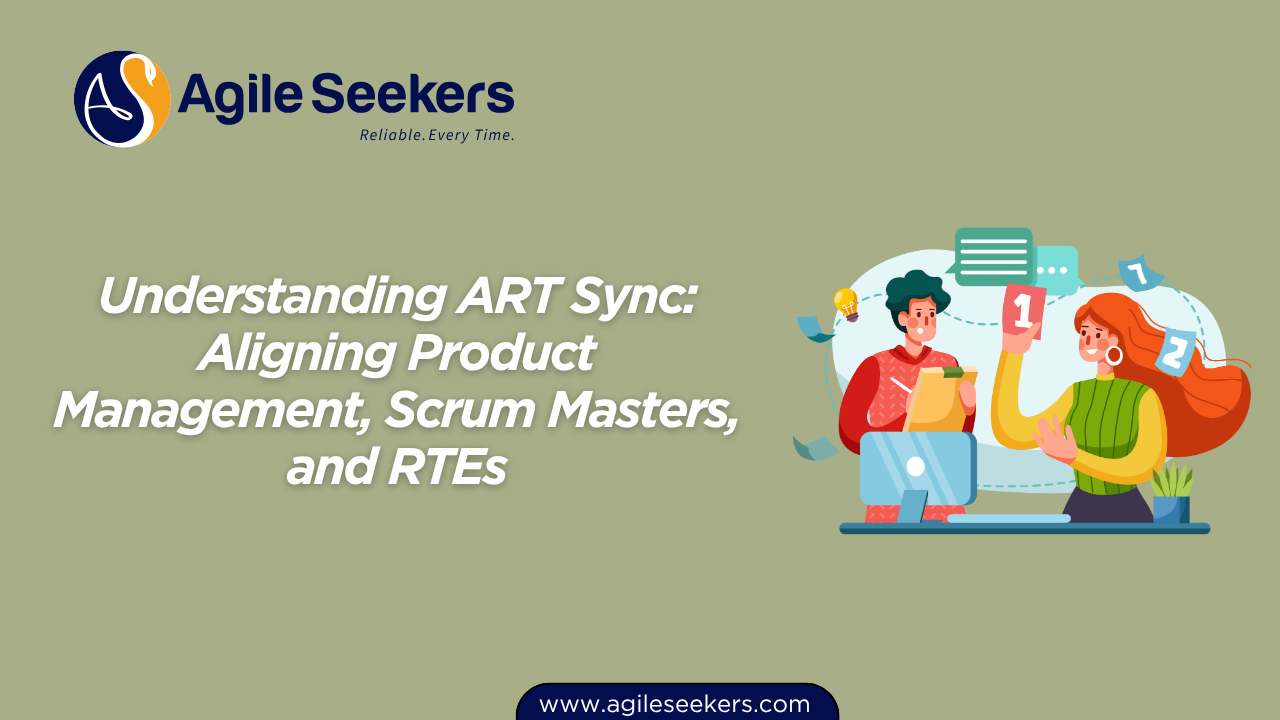Understanding ART Sync: Aligning Product Management, Scrum Masters, and RTEs

Agile Release Trains (ARTs) are built on synchronized collaboration. For an ART to consistently deliver value, three roles must operate in lockstep—Product Management, Scrum Masters, and Release Train Engineers (RTEs). This alignment doesn’t happen by accident; it’s intentionally fostered through a recurring event known as the ART Sync.
Let’s break down how the ART Sync serves as a powerful coordination mechanism, its key participants, structure, and the outcomes it aims to achieve.
What Is ART Sync?
The ART Sync is a regular coordination event (often held weekly) where the Product Management team, Scrum Masters, and the RTE come together to share updates, surface risks, resolve dependencies, and reinforce alignment across the Agile Release Train.
Rather than a status update, it’s a problem-solving and synchronization session that ensures everyone stays on course to meet PI objectives.
Core Roles in ART Sync and Their Focus
1. Product Management
Product Managers (PMs) bring the customer and business lens into the ART. During ART Sync, they:
-
Highlight changes in market conditions or customer needs
-
Reaffirm or adjust PI objectives and priorities
-
Share feature readiness status or issues blocking feature flow
-
Coordinate with Product Owners (POs) to clarify backlog alignment
The SAFe Product Owner/Product Manager (POPM) certification equips PMs with the tools to manage these dynamics and improve stakeholder alignment.
2. Scrum Masters
Scrum Masters represent their teams. They focus on:
-
Highlighting team-level risks, impediments, or dependencies
-
Communicating velocity and iteration health
-
Supporting cross-team facilitation
-
Ensuring agile practices are followed
Scrum Masters trained through the SAFe Scrum Master certification or the SAFe Advanced Scrum Master training gain the mindset and tools to bring transparency and drive team excellence.
3. Release Train Engineer (RTE)
The RTE facilitates the ART Sync. Their focus includes:
-
Keeping the ART aligned with PI objectives
-
Ensuring all voices are heard and issues are escalated if necessary
-
Tracking cross-team dependencies
-
Driving improvement through systemic problem solving
RTEs act as the chief facilitator of flow. The SAFe Release Train Engineer certification helps professionals in this role develop the competencies to orchestrate collaboration and lean governance across the ART.
Typical Structure of an ART Sync
An ART Sync usually combines two synchronized tracks:
| Sync Type | Focus | Participants | Frequency |
|---|---|---|---|
| Scrum of Scrums (SoS) | Team progress, dependencies, impediments | RTE, Scrum Masters | Weekly |
| PO Sync | Backlog, features, priorities, customer feedback | RTE, Product Managers, POs | Weekly |
In smaller ARTs, these may be merged into one integrated ART Sync. In larger ARTs, they may happen separately but be coordinated through the RTE.
Benefits of a Well-Run ART Sync
When structured and executed properly, the ART Sync delivers:
-
Real-time visibility into progress and risk
-
Faster decision-making through collective problem solving
-
Clarity around value delivery and business priorities
-
Continuous reinforcement of lean-agile culture
-
Proactive management of cross-team dependencies
ART Sync as a Feedback Loop
The ART Sync isn’t static—it acts as a feedback loop across three time horizons:
-
Daily-to-weekly: Tactical team issues, blockers, iteration goals
-
Mid-PI: Adjustments based on actual velocity, evolving needs
-
PI Boundary: Learnings for PI Planning, Inspect & Adapt, and backlog refinement
It enables relentless improvement—a principle at the core of SAFe.
Making ART Sync Effective: Key Tips
-
Keep it focused – Avoid turning it into a status meeting
-
Visualize dependencies – Use tools like PI boards, digital backlogs, or JIRA align
-
Foster psychological safety – Encourage open discussion, not blame
-
Timebox strictly – 30–60 mins max; respect everyone’s time
-
Escalate only when needed – Keep decisions at the right level
ART Sync and the Broader SAFe Framework
ART Sync doesn’t exist in isolation. It’s part of the larger cadence-based events of SAFe, such as PI Planning, System Demos, and Inspect & Adapt. All these are designed to enable alignment without central control.
The Leading SAFe® certification provides a complete understanding of how ART Sync integrates into the bigger picture of Lean Portfolio Management and cross-functional collaboration.
Real-World Example: ART Sync in Action
Let’s say a Scrum Master from Team Alpha shares a blocker: a critical API is delayed due to a dependency on Team Gamma. Meanwhile, the Product Manager realizes this delay threatens a high-priority feature delivery.
In ART Sync:
-
The Scrum Master flags the issue.
-
The RTE brings in a representative from Team Gamma.
-
The Product Manager proposes a prioritization change.
-
Together, they resolve the conflict without waiting for a leadership decision.
This is Agile in action, and ART Sync makes it possible.
External Insight: Coordination Challenges in Scaling Agile
According to Scaled Agile’s core guidance on ARTs, decentralized decision-making and alignment through cadence-based events like ART Sync enable enterprises to scale without bureaucracy.
Without this structured sync, ARTs drift into misalignment, impacting delivery predictability and morale.
Final Thoughts
ART Sync is not just a calendar event. It’s a strategic synchronization ritual that fuels alignment, fast feedback, and cross-team coordination. It bridges the gap between business strategy and delivery by empowering RTEs, Product Managers, and Scrum Masters to lead with clarity and cohesion.
Teams that invest in improving ART Sync will unlock smoother delivery, stronger trust, and a culture of continuous alignment.
Explore Agile Certification Paths That Strengthen ART Sync Collaboration:
Let ART Sync become your team’s rhythm of alignment—not just a meeting.
Also read - What Makes ART Planning Successful?
Also see - Inspect and Adapt in ARTs




















